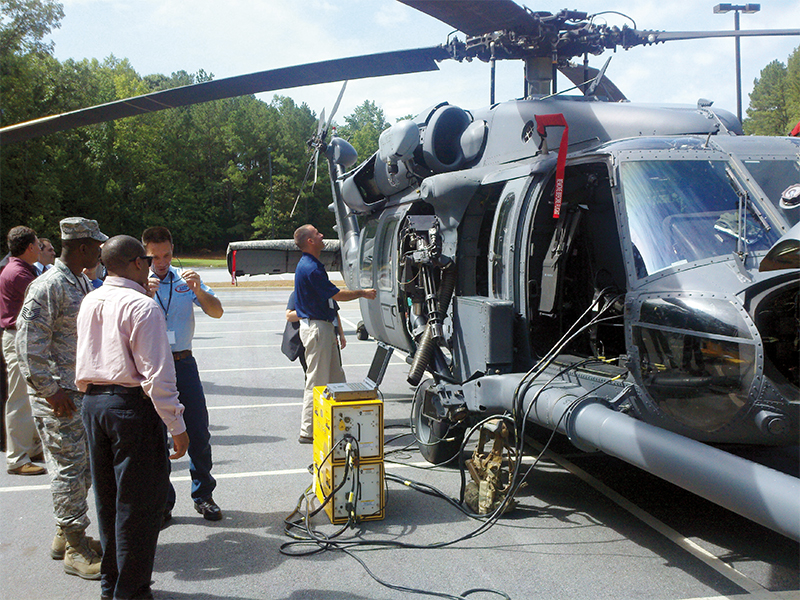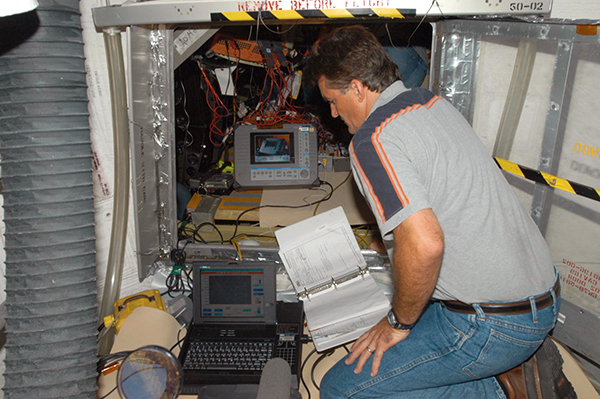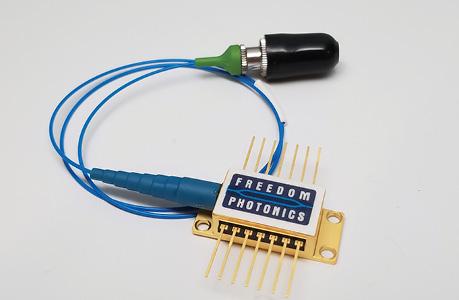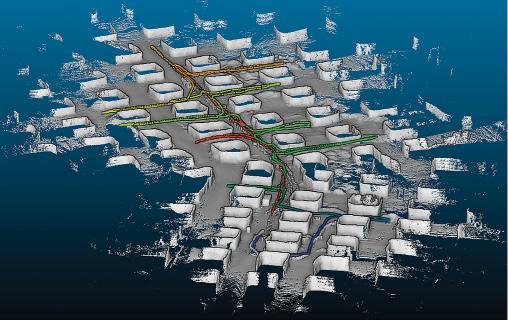
Detectors Ensure Function, Safety of Aircraft Wiring
NASA Technology
Pedro Medelius waited patiently in his lab at Kennedy Space Center. He had just received word that a colleague was bringing over a cable from a Space Shuttle solid rocket booster to test Medelius’ new invention. Medelius was calm until his colleague arrived—with about 30 other people.
“Talk about testing under pressure,” says Medelius. “There were people there from the Navy, the Air Force, and the Federal Aviation Administration.”
After the group’s arrival, Medelius took a deep breath and connected his Standing Wave Reflectometer (SWR) to the cable. He wiggled the cable around, and the display showed a fault (a short or open circuit in wire) about an inch and a half inside the connector on the cable. His colleague questioned the results, because he had already checked that area on the cable. Medelius used the SWR to check again but got the same result. “That is when we took the cable apart and looked inside,” Medelius says. “Lo and behold, that was exactly where the fault was.”
The impetus for Medelius’ new wire inspection technology came about in 1999 when one of the space shuttles lost power due to a fault somewhere in its more than 200 miles of electrical wiring. “The backup circuit was activated and prevented a major dysfunction, but nevertheless, there was a problem with the wiring,” Medelius describes.
Even though technicians used a device called a multimeter to measure the electrical current to find which wire had a fault, it could not pinpoint exactly where on the wire the fault was located. For that, technicians had to visually inspect the wire.
“Sometimes they would have to remove the whole wire assembly and visually inspect every single wire. It was a very tedious operation because the wires are behind cabinets. They go all over the place in the shuttle,” says Medelius. “NASA needed an instrument capable of telling them exactly where the faults were occurring.”
To meet NASA’s needs for a highly precise device to inspect electrical power bundles, wires, and connectors, Medelius devised the SWR. “It came down to what was affected when a wire is short circuited or opened,” he says. “We worked out a few equations based on physical principles.” The SWR proved very sensitive, and the technology was patented.
Technology Transfer
Kennedy made the technology available for commercial licensing. Corona, California-based Eclypse International was immediately intrigued by the technology, due in part to the 1996 explosion and crash of TWA flight 800. Eclypse had worked with the White House-led Air Transport Safety and Rulemaking Committee on the investigation of the accident, which, according to the National Transportation Safety Board, was most likely caused by a short circuit in its wiring. Chris Teal, marketing director at the company, says, “We were trying to find a technology to test the wiring without being intrusive or destructive.”
After obtaining an exclusive license for the SWR, Eclypse refined the SWR for commercial use by incorporating an easy-to-use keypad and making the device more rugged. “The first version was hard plastic that shattered if you dropped it. We made it tough, so none of the connectors or casing would break if it fell,” says Teal.
Benefits
Originally featured in Spinoff 2005, Eclypse has had many years of success with the NASA technology, which is now in widespread use by the military and commercial airlines, among others. As a small business that started with just 6 employees, Eclypse now employs approximately 30 people.
Called ESP+, Eclypse’s spinoff technology takes less than 5 seconds to locate a fault. “It’s the fastest and easiest to use hand-held wire tester available today,” says Teal.
Available as a standalone piece of equipment or as part of Eclypse’s Electrical Component Analysis System (ECAS), ESP+ provides step-by-step instructions to guide a user on the type and location of an electrical wiring fault.
“Mechanics who have never touched wiring can now fix it,” says Teal. “All they have to do is start the test, and in a matter of seconds, it will tell them where the fault is within 18 inches. Electrical checks that used to take two folks 8 hours can now be done in 45 minutes with one person.”
According to the company, the US Army purchased 300 ESP+ devices to include in their helicopter battle damage and assessment repair kits. In addition, one of the military programs using ECAS reported a savings of $2.19 million on development costs.
ESP+ is currently employed throughout the United States and abroad to check the health of wiring in commercial and military aircraft, submarines, sea vessels, and even presidential helicopters. A sampling of commercial customers includes Sikorsky, Boeing, Raytheon, Qantas Airlines, United Airlines, Continental Airlines, American Airlines, and FedEx. Military customers include the United States Navy, the United States Marine Corps, Australian Defense, the South Korean Army, the Spanish Navy, and Portuguese Air Forces.
In the future, Eclypse plans to promote its technology for routine maintenance of system wiring. “Our core technology and philosophy is to handle the electrical from the date it is put in service to the date of its retirement,” says Teal. The company also aims to attract the interest of networking and mainframe distribution entities and similar complex electrical industries to help ensure normal operations for their electrical wiring.
Today, Medelius says he appreciates seeing how NASA technology helps not only NASA, but everybody—even himself. “I fly a lot, and it is comforting to know that what we did helped to make flight safer. It’s a good feeling, not only as an engineering accomplishment, but from a personal standpoint.”

A NASA engineer tests wiring in the rear engine compartment of Space Shuttle Discovery. To pinpoint the location of faulty wires, a NASA contractor invented the Standing Wave Reflectometer.

Eclypse International licensed NASA technology and then commercialized the EXP+ to identify the location of a fault down the path of wiring on aircraft, submarines, sea vessels, and helicopters. Here, a HH-60G Air Force Special Operations Command intercommunications subsystem is tested.













